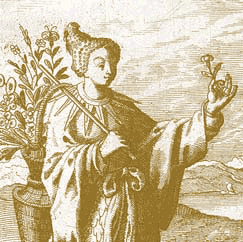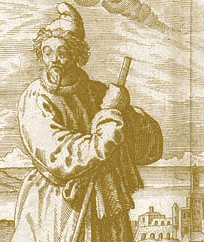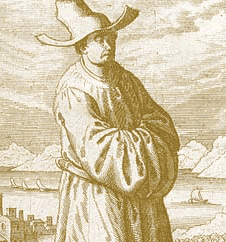| |
At top, people from China in Jan Huygen van Linschoten, Itinerareo, Amsterdam, 1596. Background image from Theodor de Bry, Petit Voyages, Frankfurt, 1599.
John Carter Brown Library.
|

This exhibit marks a transitional moment for the study of the Americas. Histories of Asia and the Americas have been traditionally narrated in isolation from each other. Yet these six texts reveal the connections that tied the hemispheres together as the Age of Exploration played forward, offering a more globally connected view of the Americas. They instruct us that reductive, nationally bounded or single-ocean historical narratives are inadequate in the early modern period. These six instances of Asian interaction with Europe and North America are but a few from the collections of the John Carter Brown Library, an institution devoted to the study the Americas.
On the occasion of the inaugural symposium of Brown University’s “Asia-Pacific in the Making of the Americas” research initiative, we are grateful to the John Carter Brown Library for opening their collection to this innovative perspective. Within the extensive holdings of this library of the Americas are hundreds of books about Asia and the Pacific. Such descriptive, illustrated travelogues and “histories” about Asia circulated widely in America, indeed were often printed in Mexico City, New York, or Philadelphia. They convey the sense of worldliness that early Americans used to identify their place on a global cultural map. Indeed, in a 1783 sermon by Ezra Stiles, “The United States Elevated to Glory and Honor,” now in the Library’s holdings, Stiles proudly calls America an “Asiatic territory” based on the presumed origins of Native Americans. At the very least, a close examination of the multitude of exchange networks that bound distant geographies together prompts questions about the hegemony of the Atlantic in American history.
 |
|
1. Bernardino de Escalante, A discourse of the nauigation which the Portugales doe make to the realmes and prouinces of the east partes of the worlde, Translated out of Spanish into English, by Iohn Frampton, London, 1579.
Bernardino de Escalante was a Spanish sailor and priest in the court of Phillip II. In 1577 he published this text in his native language, which purported to reveal Portuguese routes to China as well offer descriptions of the interior of China. Two years later John Frampton, a Bristol merchant in the Spanish trade, translated the text into English. At this time, navigational charts to China, a field in which the Portuguese dominated, were proprietary state secrets. This publication speaks to the intense competition among European states, each seeking to develop a greater presence in the Far East. Of interest in Frampton’s English translation is how a descriptive text about China becomes, in the English page subheads, a “Conquest of China,” revealing the close relationship for European explorers between global knowledge and imperial conquest. |
|
2. Jan Huygen van Linschoten, Itinerareo, Amsterdam, 1596.
Jan Huyghen van Linschoten, son of a public notary in Haarlem, emigrated to Seville and then Lisbon with his brother when he was just 13 years old. He was sent to Goa, the Portuguese trading post in India, in 1583, where he proceeded to illicitly copy Portuguese nautical maps. Back in Holland in 1595 Linschoten wrote three books relating his knowledge of the “Orient.” This is his third publication Itinerario: Voyage ofte schipvaert van Jan Huyghen van Linschoten naer Oost ofte Portugaels Indien, 1579-1592, published in 1596 and translated into English and German two years later. The images in this edition were hand colored. Among many valuable insights he offered Northern Europeans in these publications, Linschoten provided a route through the Straits of Malacca that would bypass Portuguese notice, opening the gates to the Far East to an onslaught of Dutch and English mariners, merchants, and pirates. |
|
3. Theodor de Bry, Pars Indiae (known also as Petit Voyages), Frankfurt, 1599
Theodor de Bry, a 16th-century Walloon engraver from Liege, is best known for his depictions of the Americas. Living in London in the 1580s, he met the geographer Richard Hakluyt. But it was only after settling in Frankfurt, already in his 60s, that de Bry published his first books, Les Grands Voyages, or "The Discovery of America” as well as the similar Petits Voyages, or the "India Orientalis” series. In this work de Bry engraved ten images of China, two depict gruesome scenes of torture, two of death, and two of idol worship. Whipping and encaged people figure prominently in this scene, while executed figures attached to high poles serve as background. De Bry had never traveled to China, but descriptions of Chinese torture circulated widely in Europe. Note that the buildings and perspective in his illustrations are entirely European. European and American fascination with imagined forms of Chinese punishment stands as a pervasive, age-old backdrop to the Western longing for Chinese commodities and East-West commerce in general. |
|
4. J. B. du Halde, A Description of the Empire of China … vol 1, London,
1738.
The Jesuits began arriving in China in 1552 and reached the peak of their influence under the early Qing, advising the imperial court on European science, mathematics, and astronomy and engaging in philosophical exchanges. Close to a thousand Jesuits from all over Europe participated in the China mission before 1800. During the 18th century the establishment in Rome repeatedly accused the Jesuits of leniency toward traditional Chinese rituals considered idolatrous. But their very proximity to the Chinese people allowed them a great depth of knowledge about social, economic, and political structures within Chinese society. Jean-Baptiste du Halde never traveled to China, but he collected Jesuit writings, or “letters,” on these topics and released this lavishly illustrated two-volume compendium, or “history,” in 1736. It instantly became a bestseller in the American colonies. |
|
5. Bartholomew Burges, Series of Indostan Letters, New York, 1790.
Bartholomew Burges (1740-1807) had already published the first chart of the solar system produced in the United States, A Short Account of the Solar System (1789), when A Series of Indostan Letters appeared in 1790. Burges’s book encourages American merchants’ efforts to trade directly with Asia, and it concludes with a list of commodities particularly suitable for American trade as well as a discussion of the best areas in Asia to market American goods. The glossary provides an extensive list of definitions designed to help American merchants understand “Asiatic names and terms.” A contemporary reviewer claimed the book’s “very entertaining account of the bloody battles of elephants, cocks, rams, antelopes, etc. etc.” proved wrong those who held “that literary merit does not meet with encouragement in America.” The book lists George Washington, John Adams, and Alexander Hamilton among its nearly one thousand subscribers. |
|
6. André Everard van Braam Houckgeest, Voyages de L"Ambassade de la Compagnie des Indes orientales hollandaise. Philadelphia, 1797.
Andreas Everardus van Braam Houckgeest worked as a trader for the Dutch East India Company in China from 1758 to 1773. Inspired by the American Revolution, he moved to North America in 1783 and became a U.S. citizen. In 1790 Van Braam took a position with the Dutch factory in Canton. Hearing of the Macartney embassy and hoping to succeed where the British had failed, van Braam suggested an official visit to the Qianlong Emperor. He was, therefore, part of the Dutch delegation to Beijing in 1795, becoming the first U.S. citizen to meet a Chinese emperor. The Dutch embassy, along with other tributary nations agreeing to perform the kowtow before the emperor, were lavishly entertained in the Summer Palace for Chinese New Year. Van Braam returned to Philadelphia in 1796, publishing this account of his voyage and dedicating it to George Washington. Van Braam also brought an extensive collection of Chinese art to Philadelphia, where it became an early China Trade exhibit. |

John Carter Brown Library| Box 1894 | Brown University | Providence, RI 02912
401-863-2725
About this site |







